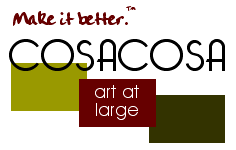



Home is a state of being as much as it is a physical location. We’re hard-wired to delve deep within our psyches to find the familiar and create connections, even in unknown places. For so many of us – immigrant, migrant, traveler, refugee – home is on the move, something to be carried with (or within) us rather than to be experienced without. A faded photo. A favorite song. A family recipe.
My own childhood home was filled with paintings from all over Central and South America. These treasures from my mother’s culture greatly inspired me as a young artist (and may have led to my affinity for bright, vibrant colors). Even more importantly, the paintings were my mother’s history of home – her youth in Nicaragua, civil war and displacement, and the uncertain possibility of return. Complicated emotions mingled with pride of place – I believe most homes can be defined in that way. Art away from home became home.
As a designer, I draw inspiration from uncovering common threads of art, culture, and family around the world. Having been exposed to people from around the world, from a very young age, I’ve developed wanderlust. My partner and I travel every year, painstakingly budgeting our finances and time for the next trip. While our goals have focused on seeing culturally significant sights like Angkor Wat in Cambodia and Macchu Picchu in Peru, it’s more often the journeys along the way that are most memorable. We’ve spent time with the indigenous hill tribe people of the golden triangle and met the Uros on their floating islands in Lake Titicaca. Every encounter, every dialogue reaffirms the deep emotional connections shared across borders of country or culture – the need to create a sense of belonging, of community, of home.
In 2013, we planned a grand adventure roaming from Egypt to Turkey to Tanzania and Zanzibar. I’d longed to see the Pyramids; their ingenuity, organization, vision, spirituality, and design are the epitome of “textbook” public art. A major caveat arose, however; tens of thousands of Egyptians were once again in the streets, protesting the actions of their recently elected President. In spite of warning from the U.S. State Department and the concerns of family and friends, we decided to go ahead with our trip and experience that moment in history.
The ancient city of Alexandria slowly peered through the clouds as our plane descended, and time seemed to stand still. It was late at night, and my nerves started getting the better of me. When we finally began circling Cairo, the emotion from the city was already palpable in the air. Notorious for their use of lasers, the protestors below us were shining lights all over the plane, making the landing more difficult for the pilot. Once safely on the ground, however, my fears subsided. Cairo seemed a world torn between the ancient and the modern, its people trying to reconcile conflicting notions of nationalism, capitalism, and democracy – not so very different, in some ways, than our debates at home.
Being an art history nerd, my first stop in the city was the Museum of Egyptian Antiquities, located on Tahrir Square, the epicenter of the protests. The exterior of the Museum had an endless line of tanks parked around it. (I lost count at twenty in the front alone.) A small crowd hurried us down the street.; they were curious (and/or trying to sell us souvenirs). Entering the museum courtyard was then a sudden catharsis, the most poignant and telling moment of my time in Cairo.
Lore has it that Anubis, the jackal-headed Egyptian god of the afterlife, held a scale on which to weigh the hearts of the dead. Hearts that were light would live on; hearts that were heavy would be destroyed. An ancient stone statue of Anubis now ironically gazed over my head toward Tahrir Square. Behind him, the museum was charred, hollowed, and ominously vacant from the last protests in 2011. At that moment, my definition of art – what it was, could, and can be – forever changed. After seeking out major “sights” around the world and being accultured to place value on certain art pieces over others, I realized it was time to scrap such suggestions. Anubis was impressive (though mostly due to his age). The museum building, an imposing governmental structure, was (from what I could tell) horribly designed, hefty, and a visual eyesore. Yet it became an artifact of immeasurable importance, juxtaposed against some of its country’s most significant and culturally valued artwork. In that moment I understood more of what was going on in Egypt than CNN, Al Jazeera, and the BBC could express in a news report. This government building, burned in protest (intentionally or not) became a piece of art, a grave expression of the frustration and anguish of the Egyptian people.
Out of one’s element. Absent the familiar. Away from home. In those moments, through those experiences, we define and broaden our awareness of the world. To travel is to learn, and I hope to never stop traveling. And art away from home, at its core, is an expanding concept advancing change – through place, emotion, narrative, and dialogue. Such sublime human expression allows us to communicate, beyond language or doctrine, to find a common ground on which to build new bridges of understanding.
Gerardo McGarity-Alegrett is an artist, designer, webmaster, and world traveler who currently serves as COSACOSA's Technology Specialist.
Artolatry bread image after Salvadore Dalí's Basket of Bread (1926).